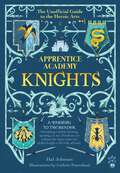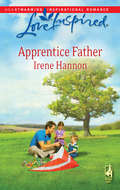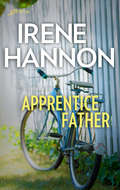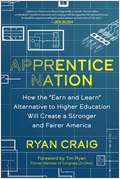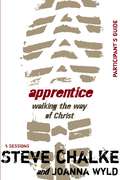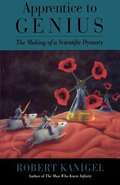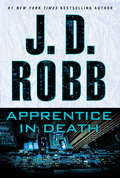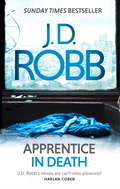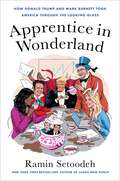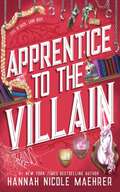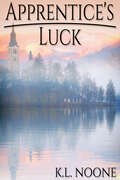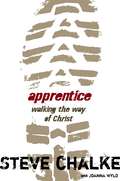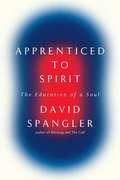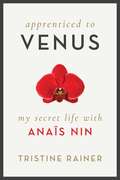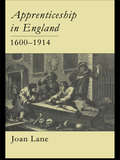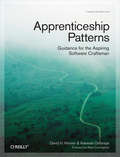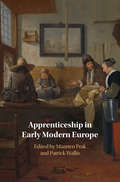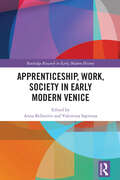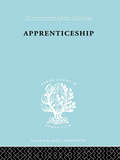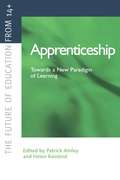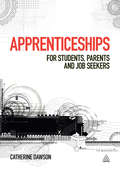- Table View
- List View
Apprentice Academy: The Unofficial Guide to the Heroic Arts (Apprentice Academy)
by Hal JohnsonCongratulations on your acceptance to the Apprentice Academy, one of the world’s finest institutions for knightly education. Your course of study here will prepare you for a career as a knight, samurai, Viking, or really any type of sword-swinging warrior. Swinging a sword is inherently dangerous, but this guide will help you complete your education while minimizing the twin risks of 1. getting maimed and 2. working too hard.Learn how to:• Fight people!• Fight dragons!• Fight monsters!• Fight everything else!• Die honorably!• And more!Please follow all instructions carefully. If you go off on your own and try something silly, and then get your head chopped off or your body bitten in two, don’t start drafting a letter of complaint. You had fair warning.
Apprentice Academy: The Unofficial Guide to the Magical Arts (Apprentice Academy)
by Hal JohnsonFor readers who have always wanted to enroll in a school for magic--be it Hogwarts with Harry Potter or Camp Halfblood with Percy Jackson! Wizard lovers will delight in pretending they’re learning magic from a cheat-sheet handbook from an elite school for sorcery.Welcome to the Apprentice Academy. Congratulations on your acceptance to one of the world’s finest institutions for sorcery. Your course of study here will be long and perilous, but this book of sorcery skills and fascinating tales from the world of magic will help you along the way—ideally with all your limbs and wits intact.Learn how to:· Read minds!· Prophesize!· Perform a love spell!· Choose an animal familiar!· Turn anything into gold!· Summon demons!· Find a lair!· And more!But most of all learn to cheat, or, rather, to weasel through without actually cheating.Please follow all instructions carefully, as one wrong move can transform your hands into forks or serpents, and then you will have a hard time turning the page.Inspired by folklore and mythology around the world, Apprentice Academy: Sorcerers is a rich, multicultural exploration and celebration of magic from not just Europe, but also from Africa, Asia, the Middle East, and the Americas. Narrated by a witty and weaseling character who supplies cheat sheets to students, Apprentice Academy opens the door on an exciting new world of magic and myth, chivalry and royalty, with the second book in the series–Knights–scheduled for Spring 2024.
Apprentice Father
by Irene HannonHis orphaned niece and nephew are depending on Clay Adams. This commitment-phobe substitute dad needs help, and he needs it fast! Nanny Cate Shepard comes to his rescue just in the nick of time. Cate is no stranger to tragedy, and her deep, abiding faith has led her through her darkest days. With God's help, her kindness and nurturing can heal the children...but what about Clay? Will this father in the making abandon his lone-wolf ways to give Cate and the children the forever family they deserve?
Apprentice Father
by Irene HannonDaddy in TrainingHis orphaned niece and nephew are depending on Clay Adams. This commitment- phobe substitute dad needs help, and he needs it fast! Nanny Cate Shepard comes to his rescue just in the nick of time. Cate is no stranger to tragedy, and her deep, abiding faith has led her through her darkest days. With God’s help, her kindness and nurturing can heal the children... but what about Clay? Will this father in the making abandon his lone-wolf ways to give Cate and the children the forever family they deserve?Originally published in 2009
Apprentice Nation: How the "Earn and Learn" Alternative to Higher Education Will Create a Stronger and Fairer America
by Ryan CraigCollege isn&’t for everyone. It&’s time to challenge the status quo and embrace the potential of apprenticeships in tech, healthcare, finance, and more—which can provide a sustainable pathway to economic opportunity. For decades, college has been the only respectable way to access the world of work, despite paralyzing tuition and a dire lack of practical skills that has left 40 percent of college graduates underemployed, unfulfilled, and struggling to repay student loan debt. Education and workforce expert Ryan Craig explores how a modern apprenticeship system will allow students and job seekers to jump-start their careers by learning while they earn—ultimately leading to greater workforce diversity and geographic mobility. With a deep dive into the history behind America&’s outdated college system, Craig reveals: The origins of the student debt crises and admissions scandals Why apprenticeships are an effective pathway to career opportunity What America can do to catch up with other nations making apprenticeship opportunities broadly available Where students and job seekers can go to land an apprenticeship Featuring a directory of US apprenticeship programs by industry and location, Apprentice Nation is an accessible blueprint for a country where young Americans of all backgrounds can launch careers in a variety of in-demand fields. With just a few common sense changes to education and workforce development, anapprentice nation will put the American Dream within reach—for everyone.
Apprentice Participant's Guide: Walking The Way Of Christ
by Steve ChalkeThe quest for meaning and purpose dwells within all of us. Jesus insisted that its fulfillment lay in a relationship with him. But what does that look like-really? Apprentice encourages us to ask our most probing questions, embrace our doubts and learn why we are driven to belong. Designed for use with the Apprentice five-session DVD study, use this participant’s guide as you follow bestselling author Steve Chalke in guiding us into a deep experience of learning and relationship with Jesus. Embarking on a relational journey that engages us on every level, we learn to walk with Jesus in an organic, whole-life learning experience, exploring areas foundational to the meaning and depth we crave. In five sessions the author covers the following topics. •Journeying: Life is like a journey best walked one step at a time •Longing: Satisfaction comes from longing for the things God longs for •Believing: Our knowledge is always limited, in the end we have to put our trust in something •Questioning: Without room for doubt, faith could not exist •Belonging: Living in community requires trust and love. It is dangerous and risky, but ultimately worth the risk
Apprentice To Genius: The Making Of A Scientific Dynasty
by Robert KanigelRobert Kanigel takes us into the heady world of a remarkable group of scientists working at the National Institutes of Health and the Johns Hopkins University: a dynasty of American researchers who for over forty years have made Nobel Prize- and Lasker Award-winning breakthroughs in biomedical science.
Apprentice in Death (In Death 43)
by J. D. Robb<P>Lieutenant Eve Dallas must hunt down the deadly snipers terrorizing Manhattan in this fast-paced In Death thriller from J. D. Robb. <P>The shots came quickly, silently, and with deadly accuracy. Within seconds, three people were dead at Central Park’s ice-skating rink. The victims: a talented young skater, a doctor, and a teacher. As random as random can be. <P>Eve Dallas has seen a lot of killers during her time with the NYPSD but never one like this. A review of the security videos reveals that the victims were killed with a tactical laser rifle fired by a sniper, who could have been miles away when the trigger was pulled. And though the list of locations where the shooter could have set up seems endless, the number of people with that particular skill set is finite: police, military, professional killer. <P>Eve’s husband, Roarke, has unlimited resources—and genius—at his disposal. And when his computer program leads Eve to the location of the sniper, she learns a shocking fact: There were two—one older, one younger. Someone is being trained by an expert in the science of killing, and they have an agenda. Central Park was just a warm-up. <P>And as another sniper attack shakes the city to its core, Eve realizes that though we’re all shaped by the people around us, there are those who are just born evil... <P><b>A New York Times Bestseller</b>
Apprentice in Death: An Eve Dallas thriller (Book 43) (In Death #43)
by J. D. RobbNature versus nurture...The shots came quickly, silently, and with deadly accuracy. Within seconds, three people were dead at Central Park's ice skating rink. The victims: a talented young skater, a doctor, and a teacher. As random as random can be.Eve Dallas has seen a lot of killers during her time with the NYPSD, but never one like this. After reviewing security videos, it becomes clear that the victims were killed by a sniper firing a tactical laser rifle, who could have been miles away when the trigger was pulled. And though the locations where the shooter could have set up seem endless, the list of people with that particular skill set is finite: police, military, professional killer.Eve's husband, Roarke, has unlimited resources - and genius - at his disposal. And when his computer program leads Eve to the location of the sniper, she learns a shocking fact: There were two-one older, one younger. Someone is being trained by an expert in the science of killing, and they have an agenda. Central Park was just a warm-up. And as another sniper attack shakes the city to its core, Eve realizes that though we're all shaped by the people around us, there are those who are just born evil...
Apprentice in Wonderland: How Donald Trump and Mark Burnett Took America Through the Looking Glass
by Ramin SetoodehFrom the editor in chief of Variety and author of the New York Times bestseller Ladies Who Punch, the never-fully-told, behind-the-scenes story of Donald Trump and The Apprentice, the long-running reality series that catapulted him to the White House. <P><P> Here for the first time is the definitive untold story of Donald Trump’s years as a reality TV star. Trump himself admits he might not have been president without The Apprentice. Now, just as he uncovered the chaos inside the daytime favorite The View in his bestselling Ladies Who Punch, Ramin Setoodeh chronicles Trump’s dramatic tenure as New York’s ultimate boss in the boardroom, a mirage created by Survivor producer Mark Burnett and NBC boss Jeff Zucker. With unprecedented access, including hours of interviews with Trump, his boardroom advisers George Ross and Carolyn Kepcher, Eric Trump, and some of the most memorable contestants, and writing with flair and authority, Setoodeh shares all the untold tales from this legendary show that has left its mark on popular culture, shaped the legend of its star, and ultimately changed American history. <p> <b>New York Times Bestseller</b>
Apprentice to the Villain (Assistant And The Villain Ser. #2)
by Hannah Nicole MaehrerNOTICE TO STAFF: There has been a disturbing increase in cheeriness, sprightly behavior, and overall optimism of late. Please resume your former dark, ominous terrors at your earliest convenience. —Mgmt Evie Sage has never been happier to be the assistant to The Villain. Who would have thought that working for an outrageously handsome (shhh, bad for his brand) evil overlord would be so rewarding? Still, the business of being bad is demanding, the forces of good are annoyingly persistent, and said forbidding boss is somewhat…er, out-of-evil-office. But Rennedawn is in grave trouble, and all signs—Kingsley’s included—point to catastrophe. Something peculiar is happening with the kingdom’s magic, and it’s made The Villain’s manor vulnerable to their enemies...including their nemesis, the king. Now it’s time for Evie to face her greatest challenge: protecting The Villain’s lair, all of his nefarious works, and maybe (provided no one finds out) the entire kingdom. No pressure, Evie. It’s time to step out of her comfort zone and learn new skills. Like treason. Dagger work. Conspiring with the enemy. It’s all so…so…delightfully fun. But what happens when the assistant to The Villain is ready to become his apprentice?
Apprentice's Luck
by K. L. NooneApprentice magician Talisman Morning has always been lucky. It’s a problem.Talis knows his luck is a magical talent -- but he can’t control it. And good luck for him can mean bad luck for other people, and a lot of trouble. He’s beginning to wonder whether he belongs with the magicians at all, or whether he should give up and run away ... until he meets a royal guard who asks for his help.King’s guard Jeryn de Machaut could use a magician. He thinks he’s overheard a plot against the king, but he has no evidence and no support. But a wayward apprentice with a knack for being in the right place -- and stumbling over hidden objects -- might be exactly the luck Jer needs.Together, Jer and Talis will uncover a palace conspiracy, save a king, and find their own best chance at love.
Apprentice: Walking the Way of Christ
by Steve Chalke Joanna WyldThe quest for meaning and purpose dwells within all of us. Jesus insisted that its fulfillment lay in a relationship with him. But what does that relationship look like—really? Apprentice calls spiritual pilgrims, both Christians and non-Christians, to exchange the shallow diversions of secular and religious culture for the pursuit of our true desires. In a book of refreshing honesty, great heart, and rich creativity, Steve Chalke guides us into an apprenticeship with the master teacher, Jesus. Embarking on a relational journey that engages us on every level, we walk with Jesus in an organic, whole-life learning experience, exploring ten areas foundational to the meaning and depth we crave. Apprentice encourages us to ask our most probing questions, embrace our doubts, and learn why we are driven to belong. Combining story and parable with thoughtful commentary, we discover the ancient art and discipline of apprenticeship— living lives stamped with the character, presence, and impact of Jesus.
Apprenticed to Spirit
by David SpanglerAn absorbing memoir of one man’s path to understanding how we can learn to lead lives of greater blessing and to be sources of blessing and service for the world as a whole. For as long as he can remember, David Spangler has been physically aware of a spiritual world existing alongside this one. In 1965, David Spangler left college to follow an inner spiritual calling and encountered an extraordinary presence, which he named “John. ” Over the next quarter-century John would assist David in exploring the “inner worlds” of the spirit, and would tutor him in some of the most basic mysteries of life and the nature of the human spirit. In Apprenticed to Spirit, Spangler recounts how John showed him the way to develop a spiritual intelligence—what Spangler calls “a mind of the soul”—and how to integrate it into everyday life. Spangler learned to think with his soul and embarked on the apprenticeship to understanding the sacredness of our world and of the realms beyond ours—a journey that continues to this day. .
Apprenticed to Venus: My Secret Life with Anaïs Nin
by Tristine RainerA Revealing Look at the Mentorship—and Manipulation—of Anaïs NinIn 1962, eighteen-year-old Tristine Rainer was sent on an errand to Anaïs Nin’s West Village apartment. The chance meeting would change the course of her life and begin her years as Anaïs’s accomplice, keeping her mentor’s confidences—including that of her bigamy—even after Anaïs Nin’s death and the passing of her husbands, until now.Set in the underground literary worlds of Manhattan and Los Angeles during the sixties and seventies, Tristine charts her coming of age under the guidance of the infamous Anaïs Nin: author of the erotic bestseller Delta of Venus, lover to Henry Miller, Parisian diarist, and feminist icon of the sexual revolution. As an inexperienced college-bound girl from the San Fernando Valley, Tristine was dazzled by the sophisticated bohemian author and sought her instruction in becoming a woman. Tristine became a fixture of Anaïs’s inner circle, implicated in the mysterious author’s daring intrigues—while simultaneously finding her own path through love, lust, and loss. In what Kirkus calls a “spicy and saucy hybrid of memoir and novel,” Apprenticed to Venus brings to life a seductive and entertaining character —the pioneer whose mantra was, “A woman has as much right to pleasure as a man!”An intimate look at the intricacies—and risks—of the female mentor-protégé relationship, Tristine Rainer’s Apprenticed to Venus stories her deep friendship, for good or ill, with a pivotal historical figure.
Apprenticeship In England, 1600-1914
by Joan LaneFirst published in 1996. Routledge is an imprint of Taylor & Francis, an informa company.
Apprenticeship Patterns: Guidance for the Aspiring Software Craftsman
by Dave Hoover Adewale OshineyeAre you doing all you can to further your career as a software developer? With today's rapidly changing and ever-expanding technologies, being successful requires more than technical expertise. To grow professionally, you also need soft skills and effective learning techniques. Honing those skills is what this book is all about. Authors Dave Hoover and Adewale Oshineye have cataloged dozens of behavior patterns to help you perfect essential aspects of your craft.Compiled from years of research, many interviews, and feedback from O'Reilly's online forum, these patterns address difficult situations that programmers, administrators, and DBAs face every day. And it's not just about financial success. Apprenticeship Patterns also approaches software development as a means to personal fulfillment. Discover how this book can help you make the best of both your life and your career. Solutions to some common obstacles that this book explores in-depth include: Burned out at work? "Nurture Your Passion" by finding a pet project to rediscover the joy of problem solving.Feeling overwhelmed by new information? Re-explore familiar territory by building something you've built before, then use "Retreat into Competence" to move forward again.Stuck in your learning? Seek a team of experienced and talented developers with whom you can "Be the Worst" for a while."Brilliant stuff! Reading this book was like being in a time machine that pulled me back to those key learning moments in my career as a professional software developer and, instead of having to learn best practices the hard way, I had a guru sitting on my shoulder guiding me every step towards master craftsmanship. I'll certainly be recommending this book to clients. I wish I had this book 14 years ago!"-Russ Miles, CEO, OpenCredo
Apprenticeship for Adulthood: Preparing Youth for the Future
by Stephen F. HamiltonAs America's need for productive workers increases, Hamilton explains how apprenticeship would exploit workplaces as learning environments, helping young people to make the crucial connections between school learning, community participation, and a satisfying, constructive life's work.
Apprenticeship in Early Modern Europe
by Maarten Prak Patrick WallisThis is the first comparative and comprehensive account of occupational training before the Industrial Revolution. Apprenticeship was a critical part of human capital formation, and, because of this, it has a central role to play in understanding economic growth in the past. At the same time, it was a key stage in the lives of many people, whose access to skills and experience of learning were shaped by the guilds that trained them. The local and national studies contained in this volume bring together the latest research into how skills training worked across Europe in an era before the emergence of national school systems. These essays, written to a common agenda and drawing on major new datasets, systematically outline the features of what amounted to a European-wide system of skills education, and provide essential insights into a key institution of economic and social history.
Apprenticeship in Literacy: Transitions Across Reading and Writing, K-4
by Tammy Jones Linda DornGrounded in social and cognitive learning theories, the second edition of Apprenticeship in Literacy: Transitions Across Reading and Writing, K-4 still details the seven principles of apprenticeship learning and helps K -4 teachers implement and assess guided reading, assisted writing, literature discussion groups, word study lessons, and literacy centers across an integrated curriculum. The new edition also features the following: Updated research emphasizing the importance of early reading as a road map for successInformation on how behaviors, from emergent to fluent, align to the Common Core State StandardsDozens of new classroom examples-;students' work, photographs, transcripts, teacher-student conferences, and reproducible resourcesLanguage prompts that promote self-regulated learnersSchedules for implementing a workshop framework in whole-group, small-group, and one-to-one settingsSuggestions for incorporating information texts into a balanced literacy programStronger emphasis on the importance of the writing processAdditional ideas on establishing routines and organizing the classroomThe theme of apprenticeship in literacy resonates throughout the book: children learn from teachers and teachers learn from one another as they promote children's transfer of knowledge across multiple contexts. The final chapter provides real-world examples of teachers working together to ensure that all children become literate.Since its original publication in 1998, Apprenticeship in Literacy has become a teacher favorite, covering all aspects of a balanced literacy program in an integrated manner and showing how all components are differentiated to address the needs of diverse learners. An apprenticeship approach to literacy emphasizes the role of the teacher in providing demonstrations, engaging children, monitoring their understanding, providing timely support, and ultimately withdrawing that support as the child gains independence.
Apprenticeship, Work, Society in Early Modern Venice
by Anna Bellavitis Valentina SapienzaApprenticeship in early modern Europe has been the subject of important research in the last decades, mostly by economic historians, but the majority of the research has dealt with cities or countries in Northern Europe. The organization, evolution and purpose of apprenticeship in Southern Europe are much less studied, especially for the early modern period. The research in this volume is based on a unique documentary source: more than 54,000 apprenticeship contracts registered from 1575 to 1772 by the ‘Old Justice’, a civil court of the Republic of Venice in charge of guilds and labour disputes. An archival source of such scale provides a unique opportunity to historians and this is the first time that primary research on apprenticeship is leveraging such a large amount of data in one of the main economic centres of early modern Europe. This book brings together multiple perspectives including social history, economic history and art history and is the outcome of an interdisciplinary collaboration between historians and computer scientists. Apprenticeship, Work, Society in Early Modern Venice will appeal to students and researchers alike interested in the nature of work and employment in Venice and Italy as well as society in Early Modern Europe more generally.
Apprenticeship: An Enquirey into its Adequacy under Modern Conditions (International Library of Sociology)
by Kate LiepmannFirst published in 1998. Routledge is an imprint of Taylor & Francis, an informa company.
Apprenticeship: The Ultimate Teen Guide
by Penny Hutchins PaquetteIntended for high school students, this vocational reference describes 100 plus apprentice-able jobs in the construction, entertainment, health care, maintenance, personal care, production, and protective services industries, social services, and military. Each entry overviews the work performed, the job outlook and wages in the field, apprenticeship programs, and related skills. Annotation ©2005 Book News, Inc., Portland, OR (booknews.com)
Apprenticeship: Towards a New Paradigm of Learning (Institute Of Education Ser.)
by Patrick Ainley Helen RainbirdIn the light of changes the government has launched as part of its welfare to work initiatives, this text explores apprenticeship. The authors set the historical context and discuss the theoretical and practical aspects of acquiring the necessary knowledge and skills for competence.
Apprenticeships
by Catherine DawsonAs unemployment becomes an issue on every graduate's and career changer's mind, apprenticeships are becoming the most legitimate and popular routes into work. But how do you choose the apprenticeship that's right for you? And for parents, how do you support and guide your child into the best possible career path? Apprenticeships uses friendly and jargon-free language to answer all of those questions and more. Based on real life experiences and insider knowledge it dispels common misconceptions, helps you assess all the alternatives, provides self assessment questionnaires and practical guidance on the application process. For both school leavers and adult learners, this is the only resource you'll need to make an informed decision. With information on funding, your rights, developing skills as well as information on key national and regional learning providers, Apprenticeships will give you the confidence and knowledge to pursue your chosen career and compete with other candidates.
